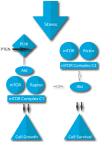The Polyphenols as Potential Agents in Prevention and Therapy of Prostate Diseases
- PMID: 31689909
- PMCID: PMC6864651
- DOI: 10.3390/molecules24213982
The Polyphenols as Potential Agents in Prevention and Therapy of Prostate Diseases
Abstract
In recent years, the progress of science and medicine greatly has influenced human life span and health. However, lifestyle habits, like physical activity, smoking cessation, moderate alcohol consumption, diet, and maintaining a normal body weight represent measures that greatly reduce the risk of various diseases. The type of diet is very important for disease development. Numerous epidemiological clinical data confirm that longevity is linked to predominantly plant-based diets and it is related to a long life; whereas the western diet, rich in red meat and fats, increases the risk of oxidative stress and thus the risk of developing various diseases and pre-aging. This review is focused on the bioavailability of polyphenols and the use of polyphenols for the prevention of prostate diseases. Special focus in this paper is placed on the isoflavonoids and flavan-3-ols, subgroups of polyphenols, and their protective effects against the development of prostate diseases.
Keywords: cancer; flavan-3-ols; isoflavones; polyphenols; prostate.
Conflict of interest statement
The authors declare no conflict of interest.
Figures














References
Publication types
MeSH terms
Substances
Grants and funding
LinkOut - more resources
Full Text Sources
Medical

